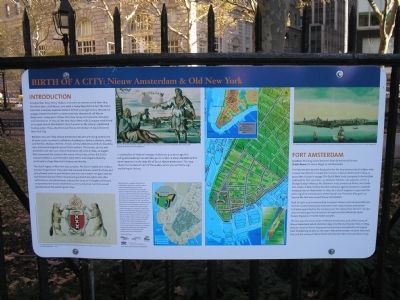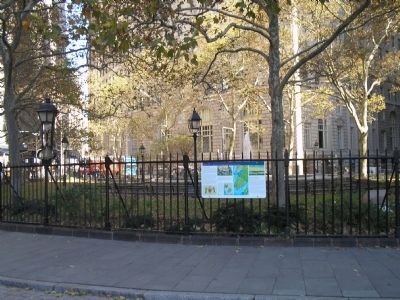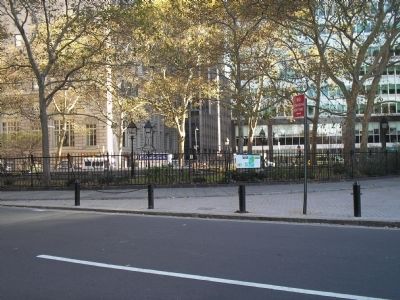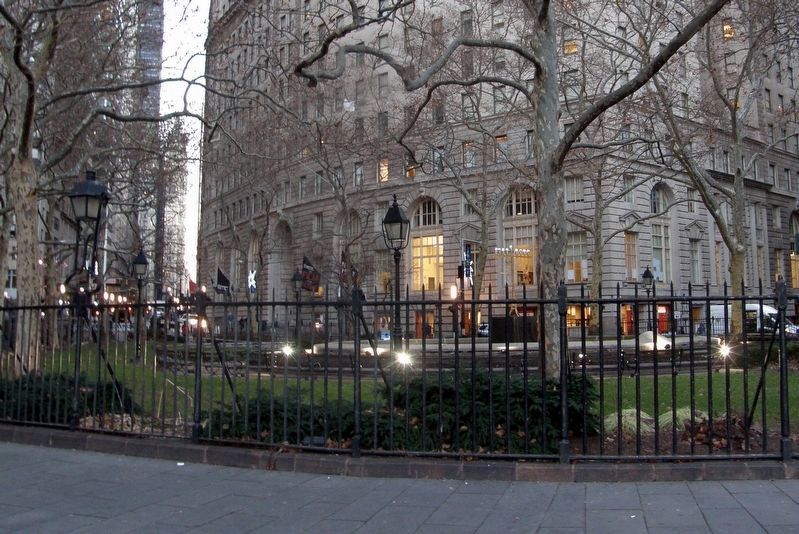Financial District in Manhattan in New York County, New York — The American Northeast (Mid-Atlantic)
Fort Amsterdam
Birth of a City: Nieuw Amsterdam & Old New York
INTRODUCTION
In September 1609, Henry Hudson and some 20 seamen sailed their ship, the Halve Maen (Half Moon), into what is today New York harbor. The Dutch East India Company expected Hudson to find a passage to Asia. Instead, his voyage allowed the Dutch to claim a territory they would call Nieuw Nederland – today parts of New York, New Jersey, Pennsylvania, Delaware, and Connecticut. In 1625-26, the new Dutch West India Company established an outpost here at Manhattan’s tip to function as the colony’s capital and trading center. They called the town Nieuw Amsterdam. It would become New York City.
Between 1625 and 1664, Nieuw Amsterdam became a thriving community of some 2,000 merchants, craftsmen, shopkeepers, farmers, laborers, slaves, and families. Walloon, Flemish, French, German, Bohemian, British, Scandinavian, and Jewish migrants joined Dutch settlers. The houses, canals, and windmills built here put a Dutch imprint on the land. In 1664, and English fleet conquered the colony in the name of the Duke of York. But Dutch cultural traditions, and the town’s early ethnic and religious diversity, continued to shape New York’s history and identity.
The Dutch legacy in New York was complex. The Dutch traded with Indians, but also fought them. They imported enslaved Africans to toil for them, but also allowed some to gain freedom and own land. Jewish refugees settled, but Director-General Petrus Stuyvesant granted them rights only after authorities in the Netherlands ordered him to do so. Through conflict and compromise, the Dutch established a community that over time would become one of the world’s great cities.
In celebration of Hudson’s voyage of discovery 400 years ago, this self guided walking tour will take you to 12 sites in lower Manhattan that were important in the daily life of Dutch Nieuw Amsterdam. The map shows the location of each of these sites, where you will find a sign explaining its history.
< Sidebar: >
FORT AMSTERDAM
Location: Bowling Green between State & Whitehall Streets
Dutch Name: De Heere Wegh at Het Marckvelt
Fort Amsterdam was the focal point for the tiny community of settlers who crossed the Atlantic to make their homes in Nieuw Nederland in 1624, 15 years after Hudson’s voyage. The Dutch West India Company in Amsterdam scattered its first colonists – 30 Walloon families – to outposts at Fort Orange (today’s Albany), the Delaware and Connecticut Rivers, and Governors Island in New York harbor. But Company agents decided to establish headquarters on Manhattan. In 1625-26, a Dutch engineer supervised the planning of Fort Amsterdam at the island’s tip. The town that grew up around the fort was
named Nieuw Amsterdam.
Built of earth and maintained by European laborers and enslaved Africans, the fort’s walls loomed over the town’s dirt roads, houses, and harbor. A director appointed by the Company ran the colony from the fort. He also commanded a garrison of soldiers to repel possible attacks by Spain, France, England, or hostile native peoples.
The fort was the nerve center of Nieuw Amsterdam, and of the colony of Nieuw Nederland which stretched deep into the countryside. Here, in 1664, Director-General Petrus Stuyvesant reluctantly surrendered to an English fleet threatening to destroy the town. Nieuw Amsterdam became New York City, and the colony of Nieuw Nederland became New York and New Jersey.
Erected 2009 by City Lore & NY 400.
Topics. This historical marker is listed in these topic lists: Colonial Era • Forts and Castles. A significant historical month for this entry is September 1609.
Location. Marker has been reported permanently removed. It was located near 40° 42.284′ N, 74° 0.832′ W. Marker was in Manhattan, New York, in New York County. It was in the Financial District. Marker was at the intersection of State Street and Battery Place, on the left when traveling south on State Street. Marker is on the fence at the southern end of Bowling Green Park. Touch for map. Marker was in this post office area: New York NY 10004, United States of America.
We have been informed that this sign or monument is no longer there and will not be replaced. This page is an archival view of what was.
Other nearby markers. At least 8 other markers are within walking distance of this location. Alexander Hamilton U.S. Custom House / National Museum of the American Indian (a few steps from this marker); Bowling Green Fence (a few steps from this marker); Broadway - The Canyon of Heroes (within shouting distance of this marker); October 28, 1886 (within shouting distance of this marker); Bowling Green (within shouting distance of this marker); May 9, 1917 (within shouting distance of this marker); a different marker also named Fort Amsterdam (within shouting distance of this marker); Places of Exchange (within shouting distance of this marker). Touch for a list and map of all markers in Manhattan.
More about this marker. Several pictures appear on the marker. The upper right of the marker contains a watercolor painting depicting the East River shore of Nieuw Amsterdam during the mid-17th century, with the fort in the left background. A picture in the upper center has a caption
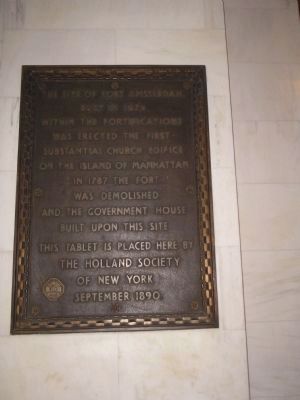
Photographed By Bill Coughlin, November 4, 2009
4. Fort Amsterdam Marker in the Custom House
built in 1626.
Within the fortifications
was erected the first
substantial church edifice
on the island of Manhattan.
In 1787 the fort
was demolished
and the Government House
built upon this site.
This tablet is placed here by
the Holland Society
of New York
September 1890.
NOTE: As of December 2018, all of the waysides in this series had been removed.
Related markers. Click here for a list of markers that are related to this marker. Learn about New York City’s colonial Dutch heritage by taking a virtual tour of the Nieuw Amsterdam Trail though lower Manhattan.
Also see . . . City Lore website. City Lore's mission is to foster New York's - and America's - living cultural heritage. (Submitted on November 5, 2009, by Bill Coughlin of Woodland Park, New Jersey.)
Additional commentary.
1. The Nieuw Amsterdam Trail
Birth of a City is a creation of City Lore, in collaboration with HH400 and the Hudson-Fulton-Champlain Quadricentennial Commission. It is funded by the Consulate
General of the Netherlands and the New York Council for the Humanities. (Any views, findings, conclusions or recommendations expressed in the exhibit do not necessarily represent those of the National Endowment for the Humanities.) The curator is historian Steven H. Jaffe, Ph.D. and design is by Emphasis Design in Brooklyn. The mapmaker is Jos Ruks. The exhibit is made possible through the cooperation of New York City Department of Parks & Recreation and the New York City Department of Transportation. Special thanks to Gajus Scheltema, Consol General of The Netherlands, historian Jaap Jacobs, Marille-vander Linden, and Femle Smeets; George Fertitta, NYC & Company; Joan K. Davidson and Liz McEnaney, Quadricentennial Commission; Margaret Newman and Anthony Galgan, NYC Department of Transportation; Jonathan Kuhn and Clare Weiss, NYC Department of Parks & Recreation.
— Submitted November 5, 2009, by Bill Coughlin of Woodland Park, New Jersey.
Credits. This page was last revised on January 31, 2023. It was originally submitted on November 4, 2009, by Bill Coughlin of Woodland Park, New Jersey. This page has been viewed 2,313 times since then and 83 times this year. Last updated on December 11, 2018, by Larry Gertner of New York, New York. Photos: 1, 2, 3. submitted on November 4, 2009, by Bill Coughlin of Woodland Park, New Jersey. 4. submitted on November 5, 2009, by Bill Coughlin of Woodland Park, New Jersey. 5. submitted on December 11, 2018, by Larry Gertner of New York, New York. • Andrew Ruppenstein was the editor who published this page.
